The Nikon 1 J1 camera and several lenses for it were provided by Oneschuk Vadim for review.
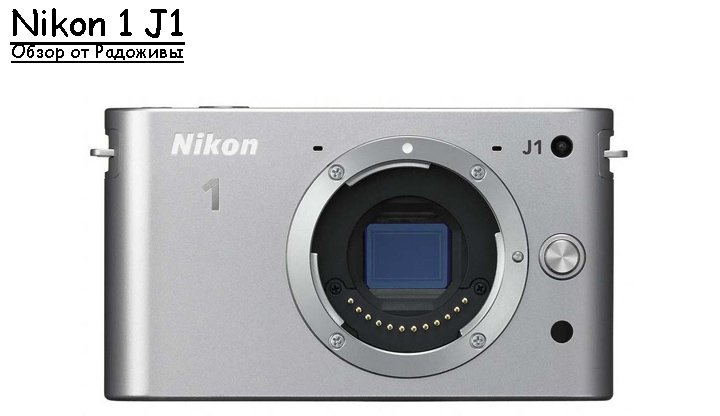
Review of the Nikon 1 J1. It looks like Nikon J1 without a lens (body)
The Nikon 1 J1 is one of six (2013) 'Nikon 1' interchangeable lens mirrorless cameras. The Nikon 1 J1 has a 'Nikon 1' mount and, for the first time since 1960, Nikon has released a range of non 'Nikon F' mount cameras. On sale you can find both Nikon 1 J1 Body (a camera without a lens) and Nikon 1 J1 kit (a camera with one or more lenses). The Nikon 1 J1 has a simple menu that anyone can understand. Shooting with a camera in automatic mode is very, very easy. But for professional use, the Nikon J1 is no good.
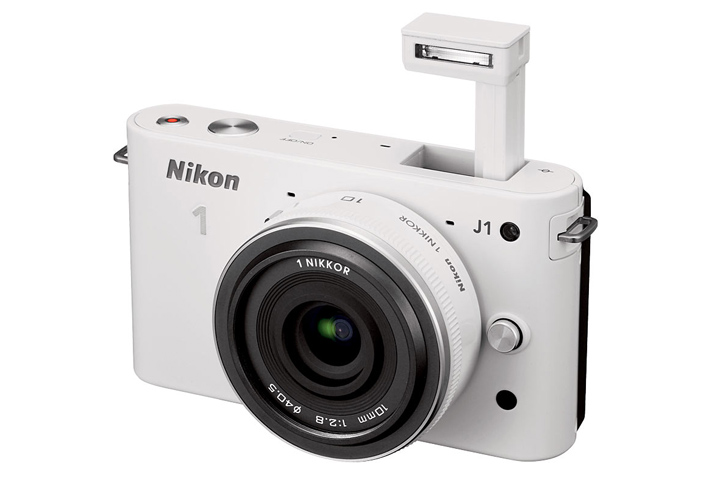
Nikon 1 J1 with fixed lens 10mm 1: 2.8 1 Nikkor. The camera can be of different colors.
Lenses
Fix Lenses:
- Nikon 1 NIKKOR 10mm f / 2.8 (black and silver)
- Nikon 1 NIKKOR AW 10mm f / 2.8 (only black)
- Nikon 1 NIKKOR 18.5mm f / 1.8 (black, silver, white)
- Nikon 1 NIKKOR 32mm f / 1.2 (black, silver)
Zoom lenses
- Nikon 1 NIKKOR VR 6.7-13mm f / 3.5-5.6 (black and silver)
- Nikon 1 NIKKOR VR 10-30mm f / 3.5-5.6 (8 color options)
- Nikon 1 NIKKOR VR 10-30mm f / 3.5-5.6 PD-ZOOM (6 color options)
- Nikon 1 NIKKOR VR 10-100mm f / 4-5.6 (5 color options)
- Nikon 1 NIKKOR VR 10-100mm f / 4.5-5.6 PD-ZOOM (only black)
- Nikon 1 NIKKOR 11-27.5mm f / 3.5-5.6 (6 color options)
- Nikon 1 NIKKOR AW 11-27.5mm f / 3.5-5.6 (black, silver, white)
- Nikon 1 NIKKOR VR 30-110mm f / 3.8-5.6 (8 color options)
- Nikon 1 NIKKOR VR 70-300mm f / 4.5-5.6 N (only black)
For myself, I would take a bunch of universal lens Nikon 1 NIKKOR VR 10-100mm f / 4.5-5.6 PD-ZOOM and portrait lens Nikon 1 NIKKOR 32mm f / 1.2, however, such a set will be quite expensive :). It's very funny that Nikon released Nikon 1 NIKKOR 32mm f / 1.2but still not updated to the autofocus version of the old Nikon 50mm 1: 1.2 AI-S.
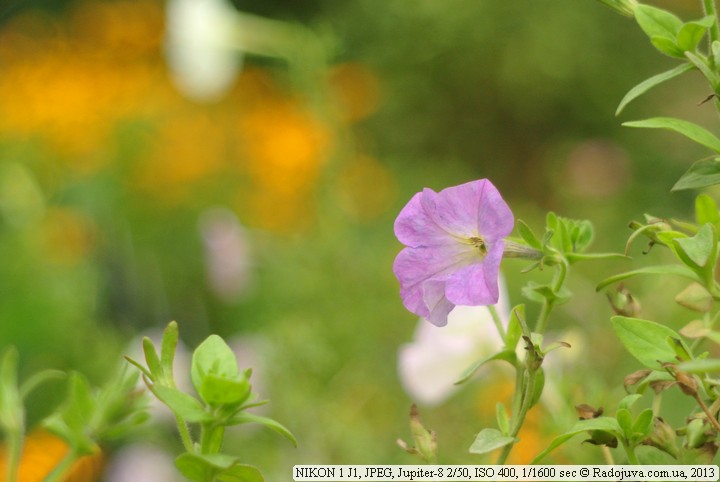
Example photo on the camera and lens Jupiter-8
There is a special list of Nikon FX, DX lenses that you can easily use on your Nikon 1 J1 camera using the FT1 adapter. More details about this issue can be found in the section on Nikon CX Lenses.
Nikon 1 J1 has a very short working length, which allows you to use many manual lenses from rangefinder cameras. But here's the trouble - Nikon 1 J1 the possibility of measurement is reduced exposure with old uncoupled optics. You can shoot with manual lenses only in 'M' mode. Modes P, A, S, M must be selected in the camera menu 'Exposure mode'.
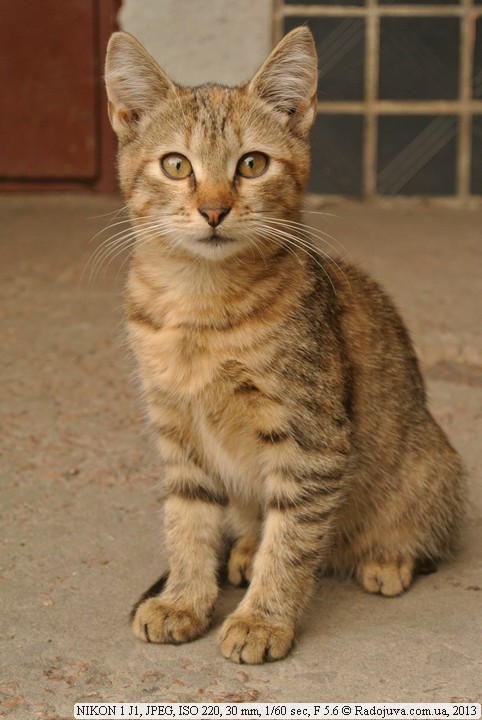
Cat on Nikon 1 J1
Matrix
Nikon 1 J1 is a tiny system camera with crop factor 2.7X. This means that matrix size Nikon 1 J1 7,3 times smallerthan any film (135th film) or any full-format camera. Matrix size plays a huge role in the construction of the image. Nikon 1 J1 sensor with a nail - 13.2 x 8.8 mm... On such a small (in physical size) matrix, 10.0 megapixels were placed. Most likely, marketing played here, because anything less than 10 MP, nowadays already causes a malicious grin. In this way, the camera can take pictures of 3,872 x 2,592 pixels (exactly 10 pixels). 036 MP - this is quite enough for amateur tasks, for example, with 224 MP you can print A10 images without any problems. In order not to bother about the number of pixels, I advise you to look at the article ' Battle of Megapixels '.
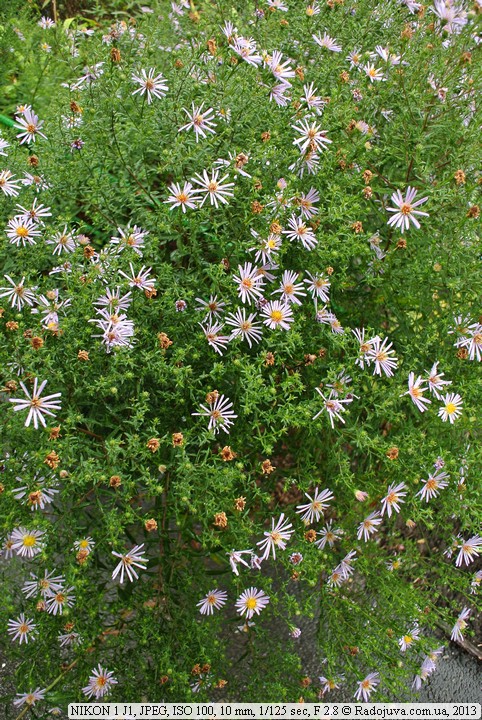
Sample photo on Nikon 1 J1 for fast fix
By the way, 3 more cameras of the Nikon 1 series use the same CMOS sensor - this is Nikon 1 J2Nikon 1 S1Nikon 1 V1. Nikon 1 J1 can use ISO from 100 to 3.200 and expand to a value of 6.400 (ISO HI 1). The camera has three auto ISO modes:
- A3200 - Uses ISO 100-3200 range
- A800 - Uses ISO 100-800 range
- A400 - Uses ISO 100-400 range
True, automatic ISO selects not the most successful excerptsmost likely focusing on the focal length of the lens (Golden Rule) So, the camera often gave me a shutter speed of 1/30 s, while I could take a picture of stationary objects without problems, but people were already blurry for 1/30 of a second.
The lower the ISO level, the less noise you can get in photos. Nikon J1 is comparable in noise level to old SLR cameras Nikon D40, D70s (noise starting from ISO 200). A miracle did not happen, and at ISO 3200 I get a good image, but the noise reduction function removes image detail. Here original shot at ISO 3200, in the photo due to the noise reduction algorithm, the cat's face became similar to Vrubel paintings. But in any case, the picture from the Nikon 1 J1 looks decent.
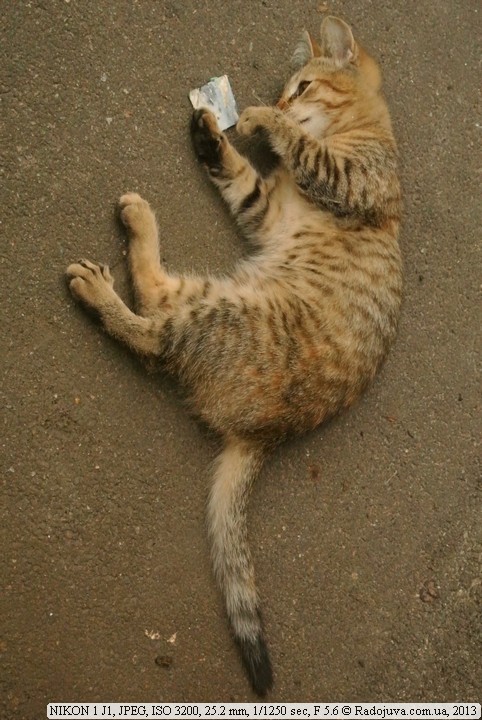
Sample photo on Nikon 1 J1 at high ISO. The cat is playing.
Nikon 1 J1, unlike mirrorless cameras Sony Nex and many others, does not have a mechanical shutter. During shooting, there is no excess noise from the movement of the shutter shutters. Also, the iris control mechanism is built into the Nikon 1 lenses themselves and is very quiet. Focusing with Nikon 1 lenses is also very, very quiet.
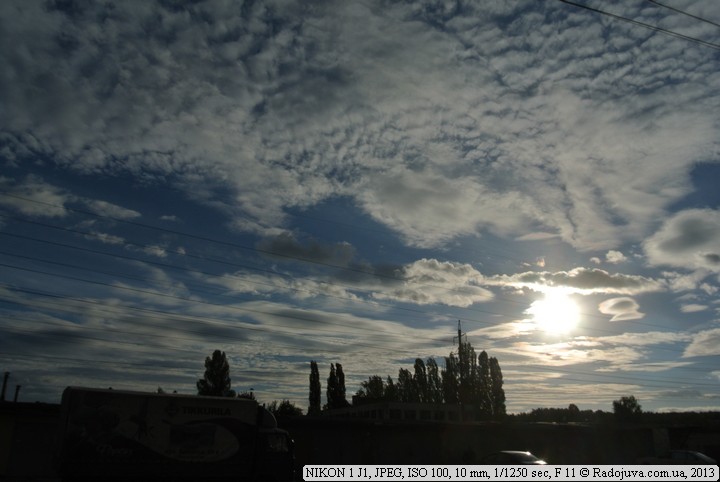
Cat on Nikon 1 J1
Very important points in the Nikon 1 J1 camera:
- the camera can use an ultra-fast shutter speed equal to 1 / 16,000 seconds. Among Nikon SLR cameras, only Nikon D1x, D1h, D1.
- the camera has neither optical nor electronic viewfinder. You can only zoom in using the camera display. A camera display 3-inch, TFT LCD type at 460.000 points.
- the camera has a built-in flash that shoots (rises) upward when you press the corresponding button. By the way, the flash works pretty well.
- There is also an auxiliary focus auto focus light, which lights up in green.
- remotely control the camera using a cheap remote control ML-L3.
- the camera has a USB output and mini type C HDMI.
- camera supports memory cards SD, SDHC, SDXC (and UHS-I).
- The battery is powerful enough, I had about 500 photos per charge.
- the camera has a sleep mode, the time after which the camera goes into this mode is configured.
- the camera has features that enhance the picture: Active D-lightning, noise reduction at high ISO and slow shutter speeds.
- the camera can be connected to an outlet using an EP-5C cable. For the camera, there is even a special GR-N2000 handle for a comfortable grip (not to be confused with the booster).
- the camera has an interesting 'Motion Snapshot' mode, during which a short video is recorded at a high frame rate per second and a photo is taken in parallel.
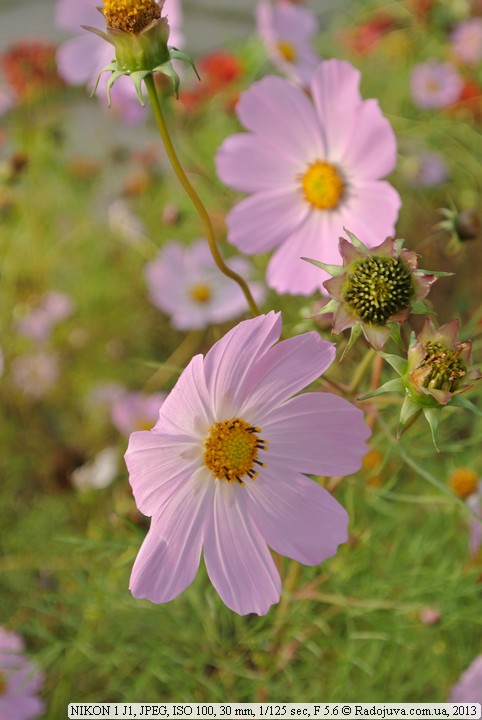
Flowers on Nikon 1 J1
Camera performance
Nikon 1 J1 weighs a little less than 300 grams, a camera with a small lens can even be placed in a jacket pocket. The camera body is made of aluminum alloy.
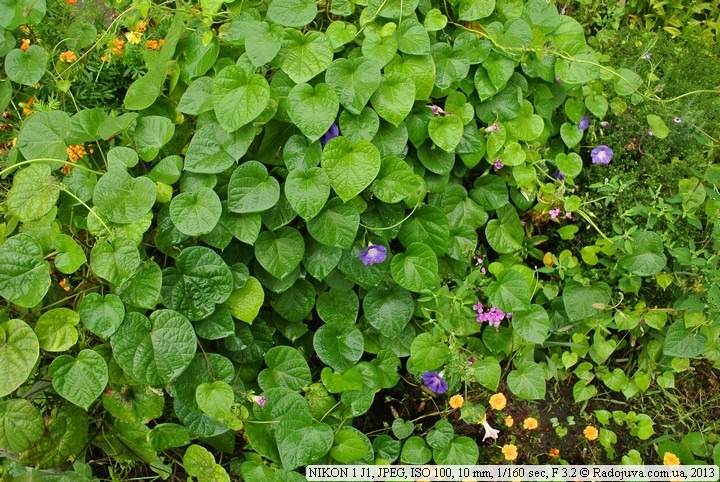
Sample photo on Nikon 1 J1
And now the fun part is this baby can take off photo at a speed of 60 (sixty) frames per second! This is an outrageous indicator. At what you can shoot 60 fps with any parameters, even RAW + JPEG. However, a serious drawback of such super-fast shooting is the very small frame buffer. The processor is responsible for image processing EXPEED 3, the same as Nikon D800, D7100.

Photo at Nikon 1 J1
Buffer:
- 12 frames in the shooting mode 'Continuous -> Electronic (BC)' with a frequency of 30 or 60 fps, moreover, with any quality settings, the buffer is always exactly 12 frames. This means that only 60/1 of a second can be shot at 5fps. At 10 fps, the buffer becomes 13 frames.
- 17 frames in JPEG, L, Fine. With this function ADL, noise reduction at high ISO, noise reduction at long exposure, auto ISO - off.
- 23 frames in JPEG, L, Fine mode, if you also switch to M mode in addition.
- 83 frame in JPEG, S, Basic mode and all disabled functions
- 14 frames in JPEG, L, Fine mode or in RAW mode or in RAW + JPEG mode with all additional functions enabled
Frame buffer turned out to be quite capacious, it's a pity you can't put 83 frames at 60 fps. In other modes, the camera can shoot at speeds up to 5 fps. And in the 'Electronic (BC)' mode, you can set 10 or 30, or 60 c.s. RAW files have 12-bit color depth and weigh an average of 10 MB. JPEG L Fine weighs an average of 5 MB.
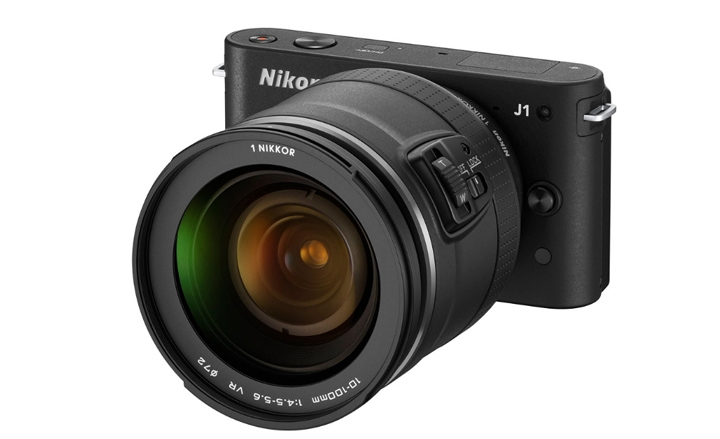
Nikon 1 J1 with super zoom
Focusing
Focusing on the Nikon 1 J1 is fast, several modes are available. You can select one focus point and know exactly where the camera focuses. In manual focus mode, you can enlarge any area of the image, but only the increase is not available when working with manual optics.
Nikon 1 J1 uses a hybrid focus method. Focusing in video mode is also fast, so the Nikon 1 J1 outperforms its mirror counterparts, where there is a serious problem with focusing speed. Typically, SLR cameras for video use contrast focusing, which is why focusing is very, very slow, even on very expensive cameras.

Nikon 1 J1 rear view
Video
A very strong point of the Nikon 1 J1 is the video. The camera can take Full HD at 60 frames per second... MPEG4 Video (H264) 1920 × 1080, AAC 48000Hz stereo 128Kbps codec in MOV container. You can also shoot at 1920 × 1080 30p or 1280 × 720 60p.
And the camera has two slow motion modes:
- 640 x 240 400 frames per second
- 320 x 120 1.200 frames per second
Just think - 1200 frames per second, while you can make really interesting videos. The movie itself is played at standard 30 frames per second, and it turns out 40-fold slowdown. The camera also has stereo microphone to record video. In aperture priority mode, aperture changes are available during movie shooting. In M mode, you can control and shutter speed and diaphragm, such a complete control of these two parameters is only in the very expensive CZK Nikon D4, D800,D800E.
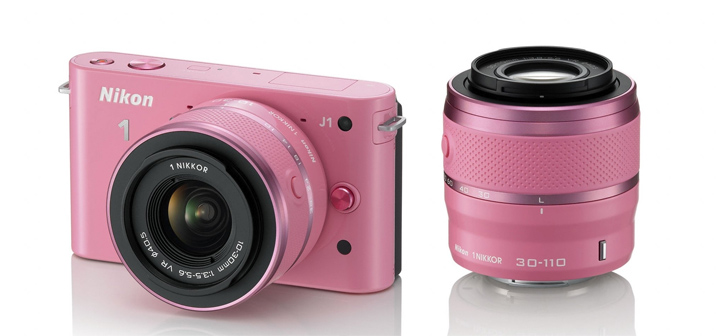
pink Nikon 1 J1 camera, you know for whom
Lenses
I used two native lenses - 1 Nikkor 10mm 1: 2.8 RF Aspherical и 1 Nikkor 10-30mm 1: 3.5-5.6 VR IF Aspherical... The lenses are very small, compact, with internal focusing. Focusing itself is fast. The lenses do not have a diaphragm control ring, focusing ring, focusing distance scale, depth of field scale, they have nothing at all :). The lens aperture is controlled by a mechanism built into the lens itself. The number of aperture blades in lenses is 7 pieces. In the removed position, the lens aperture is completely closed. The MDF lenses are 20cm and use a tiny 40.5mm filter. You can buy a lens hood for the lenses.
1 Nikkor 10-30mm 1: 3.5-5.6 VR - stock lens with stabilization. Has an interesting zoom latch. In the inactive position, the lens trunk is hidden. You need to zoom manually, like with any lens from a SLR camera. The zoom button can automatically turn on the camera. The lens has a metal mount. Weighs 1 Nikkor 10-30mm 1: 3.5-5.6 VR 115 g. Minimum aperture is f / 16. The lens can catch glare in backlighting.

Optical design of the 1 NIKKOR VR 10-30mm f / 3.5-5.6 lens
You can look at the real prices for 1 Nikkor 10-30mm 1: 3.5-5.6 VR lens in popular online stores at the following links:
Prices for modern lenses for the Nikon 1 system can be found here.
1 Nikkor 10mm 1: 2.8 RF Aspherical - fast wide-angle lens. Weighs 77 grams. Instead of a focus ring, it has a 'snag'. The minimum aperture is F / 11. The mount is metal.

Optical design of the 1 NIKKOR 10mm f / 2.8 lens
You can look at the real prices for the 1 NIKKOR 10mm f / 2.8 lens in popular online stores at the following links:
Prices for modern lenses for the Nikon 1 system can be found here.
There are no serious comments on image quality for lenses. I do not plan a detailed review of these lenses, since there is practically nothing to view. Examples of photographs on lenses:
Photo parameters: on-camera JPEG L Fine without processing. All shot in Picture Control mode SD and VI. Used white balance: 'Auto', 'Shadow', 'Direct Sunlight' and 'Cloudy Sky'. Photos have been resized to 2048px by 1363px Q = 85% (about 3MP). More photos from Nikon 1 J1 can be found in Jupiter-8 2/50 review.
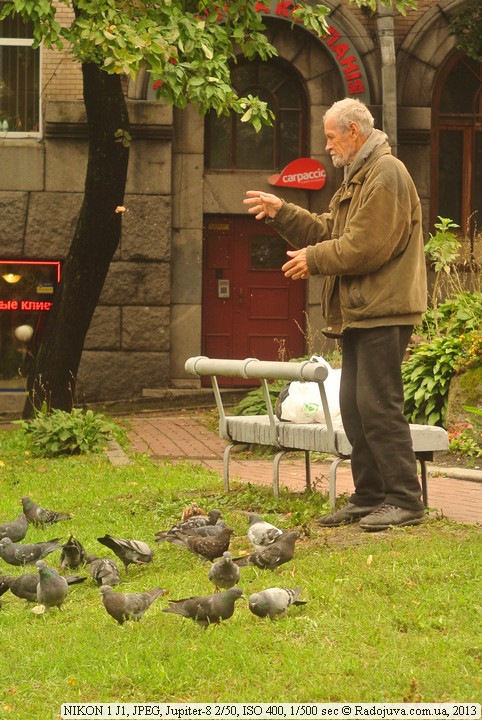
Photo on camera
Personal experience
I was extremely uncomfortable using the Nikon 1 J1. This primarily refers to the fact that the lenses do not have a manual focus ring. For any change in the settings you need to climb and poke around in the menu. But for camera enthusiasts such a camera is of great interest.
Another weird stuff I found in the camera:
- The battery cover does not snap into place.
- camera and lenses are made in China - oh, this Nikon :).
- There are 4 modes in total on the shooting mode dial. What's the rest of the 75% wheel for? It was possible to take out the modes P, A, S, M, or 'landscape', 'night portrait', etc.
- I still don't understand how the Smart Photo Selector works.
- Who needs Motion Snapshot?
- the camera does not have a very interesting HDR function for fans.
- there is no possibility to create panoramas, a trifle, but unpleasant.
- on the official website indicated that camera performance is 600 megapixels per second. But the camera can’t even take 1 second at a speed of 60 fps to get the claimed number of 600 MP / s. In fact, the camera takes 12/60 = 0,2, that is 1/5 of a second :)
If I had before me the choice of buying a camera with interchangeable lenses, then I would look towards the Sony Nex cameras. Well, if the Sony Nex is quite expensive, then instead of the Nikon J1 I would take a simple but more bulky SLR camera Nikon D3100 with a whale lens. Of course, this is just my experience and my desires.
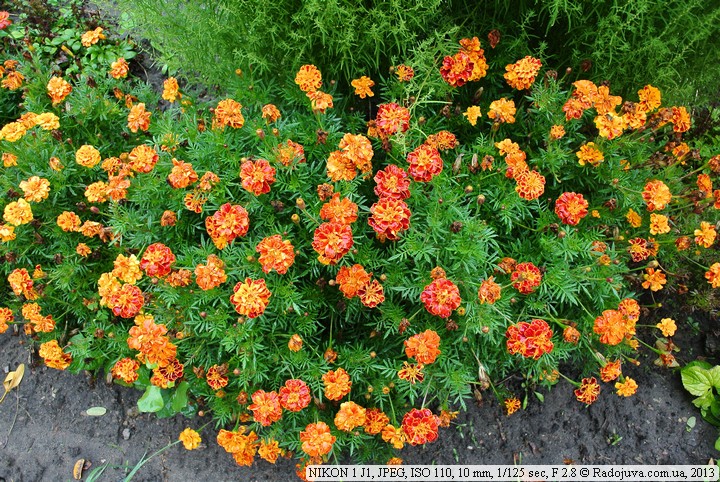
Photo at Nikon 1 J1
Camera prices
You can look at the real prices for the Nikon 1 J1 camera in popular online stores at the following links:
Prices for modern Nikon 1 cameras can be viewed here.
The exact list of system mirrorless cameras with interchangeable lenses Nikon 1:
- Nikon 1 J1, Nikon 1 J2, Nikon 1 J3, Nikon 1 J4, Nikon 1 J5.
- Nikon 1S1, Nikon 1S2
- Nikon 1 V1, Nikon 1 V2, Nikon 1 V3
- Nikon 1AW1
Comments on this post do not require registration. Anyone can leave a comment. Many different photographic equipment can be found on AliExpress.
How to configure?
People who buy such a camera usually want vibrant, vibrant, and sharp photos. To get them without unnecessary troubles, I advise you to configure the camera like this:
- Mode exposure - Auth. plot selection
- Image quality - Fine
- Image size - L
- Shooting Mode - Continuous
- Measurement exposure - Matrix
- White balance - Auto, or any other
- ISO sensitivity - A3200
- Picture Control - VI, enter this mode and set sharpness to '9'.
- Active D-lighting - On
- Reduce. noise / duration exp. - On
- Reduce. noise / high Chuv ISO - On
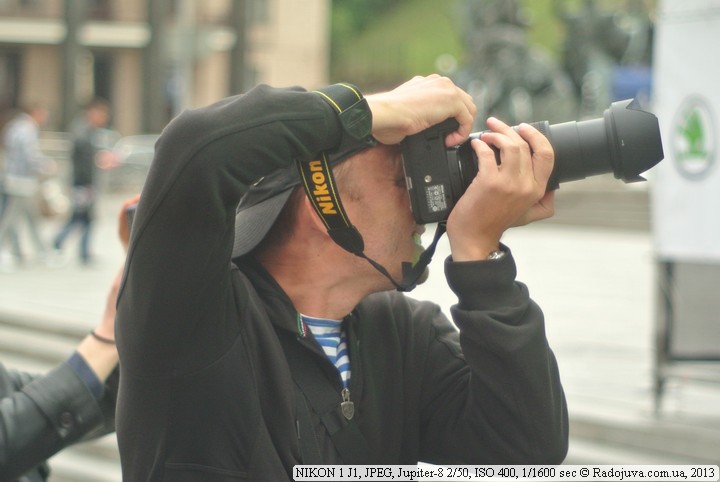
Photo at Nikon J1
Conclusions:
Nikon 1 J1 is one of the simplest cameras in the Nikon 1 line. The camera is very small and powerful: here you can shoot 60 photos in one second, and Full HD 60i (with slow motion), and a large frame buffer, and many other pleasant things. Such a camera is suitable for those who do not want to mess with large DSLRs, but want to get a fairly high-quality image and video.
In 2018, all Nikon 1 cameras were added to the archived products section of Nikon official websites.
Material prepared Arkady Shapoval. Training/Consultations | Youtube | Facebook | Instagram | Twitter | Telegram

















Interestingly, since she does not have a mechanical shutter, does she suffer from a rolling shutter? It seems like an electronic shutter is applied, but still.
And so, in addition to the speed of photo-video shooting, it merges with almost all other mirrorless cameras - take the same Sony NEX - the latest APS-C has a matrix, all automation works great with manual optics, there are a lot of interesting software chips (like noise reduction at high ISO by the method combining 6 frames).
The image is quite high quality, not counting the noise and lack of bokeh. For girls, it's almost normal, but lenses still spoil the dimensions. The battery is still eating.
If by bokeh we mean artistic blur, then I probably agree with you. But the blur is “just strong” a long-focus lens gives :-)
The so-called “manual focusing” is done by pulling the lever under the thumb, while the image is enlarged in the center, which can be adjusted (it seems like a wheel or a navipad). 0,5) and there is nothing infinity - which makes it completely useless, by the way, "manual focus" works in video
Selecting the focus point in the camera IS, you need to press the central navigation button that activates the point selection mode (if conflicting parameters are not set in the menu (face focus, auto focus area selection, etc.))
but I don’t think that there will be a special problem, the central point is quite enough, the depth of field is large and during reception “I focused on what I needed - framed - pressed the shutter” despite the parallax there should be no departures from the depth of field, only if with a 32mm f / 1.2 completely open
about blurring - no one bothers to shoot in RAW and develop in Adobe Camera RAW or Lightroom - with default settings, they kill chromatic noise well without affecting detail, though at ISO 800 and above, it will have a fair amount of grain, but for me personally it's not a problem, grain is better than soap
Unlike other non-mirror cameras, I like the Nikon 1 system in that it is REALLY compact, since the small size is not only the camera itself but also the lenses. and it’s easy to always carry with you.
In ergonomics, I would not say that it is inferior to the much younger DSLRs, but it still leaves the feeling of intentional cutting, why are PASM modes not made? Why can't I assign anything to a function button (e.g. ISO)?
the answer is probably one - what would they continue to buy the D3100, which, despite the high image quality, all other things being equal, would scare off many potential owners of size (well, those people who do not take it for creativity, but simply shoot a cat, wife, car, barbecue)
the menu is good in that it remains on the parameter that you adjusted before exiting it, and in itself is very smart, but damn it is not the answer =) moreover, things are even the same on the advanced V1 and the situation was fixed only on V2 which costs a lot of money and can’t offer any improvements besides ergonomics (which is of course important) (they raised the resolution to 14MP and the minimum ISO to 160, without improving either the dynamic range or the noise situation)
I finalized the article, thanks for clarifying some points, these are really very important points for many users. As for RAW, girls with rosy Nikon J1s are unlikely to pick RAW in Lightroom to get rid of image crystallization at high ISOs :)
"Manual focus" is done by pulling the lever under the thumb "
Have you tried to press OK first, and then rotate the multi selector? On the contrary, manual focusing is very smooth and very convenient, when you click OK, the image on the display increases, which allows you to focus very accurately.
In M mode: the lever adjusts the shutter speed, the multi-selector wheel adjusts the aperture. And manual focusing (smooth!) From macro to infinity - with the same multi-selector wheel, but after pressing the OK button. Everything is very conveniently arranged and works great.
In aperture priority and shutter speed modes, the lever works to change, respectively, the values of D and B.
I do not have a camera at hand, I took it from friends to indulge in the winter, I do not remember everything well, I could confuse the lever with the wheel, and some other little things, I really liked how this baby shoots a video, completely manual settings are super, it's a pity that any a manual lens on it will be a telephoto lens, except for super wide angles
Good day gentlemen! I'm not sure if this camera was used ... but once, when I received a lens at Novaya Pochta, I saw another man trying on this kind of camera, through an adapter, Granit-11 https://radojuva.com.ua/2011/01/obzor-arsat-80-200-granit-11/. Honestly, what I tried on, I don’t know the camera on the lens or the camera on the camera, but I don’t tell you the look of this tandem, but I’m silent about the ease of use. A little ridiculous.
Arkady, good afternoon! I would like to add pictures taken on Jay-One and lenses that you have not tested. I love taking pictures with a 30-110 mm lens (crop factor 2,7, EGF 80-270.
http://img-fotki.yandex.ru/get/5001/16286538.a/0_c7a20_d0915e48_orig 77 mm
http://img-fotki.yandex.ru/get/9258/16286538.a/0_c7a1c_72c6487d_orig 86 mm
http://img-fotki.yandex.ru/get/9361/16286538.a/0_c7a1f_4c28299d_orig 86 mm
And this is at 18 / 1.8, (I recently purchased it, just clicked a few frames):
http://img-fotki.yandex.ru/get/9258/16286538.a/0_c798c_fd17b30_orig on open.
P. S. There is no color correction, there is a decrease for the web with added sharpness. Ji-peg shooting with zero settings for sharpness, saturation, etc.
I went over the chambers, there is a dispute below about the quality of the photo), but, in my opinion, the photos are excellent. You managed to get the most out of the amateur compact.
The last photo is generally very beautiful. The portraits are also good considering the lighting conditions. I would have acquired one for myself, as it seems to me now - largely thanks to your examples!
Irina! Hello, and you still have examples with nikon j1? I'd love to see
Arkady, perhaps the 400 and 1200 fps modes are better referred to as the fast shooting modes. The first generation of Nikon 1 cameras - J1 and V1 are currently very affordable (in body and kit 10-30mm versions, of course) and may be of interest to owners of Nikon SLR cameras as a kind of teleconverter.
Oleksey, 400 and 1200 fps it is more correct to call shooting slow motion. Then there will be no ambiguity
I cannot agree with you, Roman. The subject of photography does not slow down its movement! So that there are no discrepancies, I propose to start from the understanding that a camera that does 2 fps shoots at a higher speed than one that gives 1 fps, and how then the playback takes place is not an indicator of the speed characteristics of the device.
In the article I indicated "slow motion", guided by the office. Nikon's site. The effect is done for the sake of getting slow.
The subject being filmed slows down its movement - on video In general, high-speed filming and slow-motion filming are one and the same. The projected frame rate during playback after high-speed filming is always several times lower. We read the wiki.
Otherwise, this speed did not fall to anyone.
OK, so this terminology is already well established. Indeed, it turns out that any transformation of life into a frame (no matter how often) leads to a slowdown in movement. And in the case of photography - to a stop with a limit, limited shutter capabilities (1/16000 of a second, for example), or the author's idea.
I have had this camera for a year now.
pros:
- small and light
-great video
-Excellent AF
- price (whale from 10-30 can be bought for $ 270)
Cons
- noises above ISO 100
- color and halftones
- ergonomics
- menu
- crop 2.7
RAVs do not last well. in fact, it’s rather a soap box in the picture.
now Nikon decides the fate of this system - the decline in sales of Nikon 1 - something under 50%.
maybe they’ll cover her.
examples of what I got:
http://vmirefoto.blogspot.ca/2012/11/nikon-1-j1-2810mm.html
http://vmirefoto.blogspot.ca/2013/01/1.html
http://vmirefoto.blogspot.ca/2013/06/35-nikon-1-j1-10-30vr.html
Comparison with Fuj and Nikon D5100:
http://vmirefoto.blogspot.ca/2013/06/fujifilm-finepix-s5-pro-nikon-d5100.html
10mm fix comparison with 10-30
http://vmirefoto.blogspot.ca/2012/12/nikon-1-j1-10-10-30.html
Good photos for an amateur camera! Is this Quebec in the photo? At first I thought that the USA, and then I paid attention to the inscriptions in French :)
Arkady, there is a mistake in the article - both shutter speed and aperture can be changed both in photo mode and in video mode, if you set the mode M. The shutter speed is changed with a lever, and aperture - with a wheel around the joystick.
Fixed
Used this for about six months.
Cons:
Ergonomics really are not ice, all the disadvantages are already described, this was the reason for the transition to the D90.
There are no low shooting speeds, 10fps is often too much….
Pros:
There is an automatic shutter release mode (I don’t remember what it’s called in the menu), which allows setting the desired settings to make a lot of dawn for subsequent gluing ... it is very convenient to catch lightning in a thunderstorm, with a neutral-dimming filter 30 seconds exposure during the day, yes, you can set the frame limit yourself.
Dimensions: with 10mm it fits comfortably in a pocket, without protruding it, sleepyhead is really bigger.
Here are a couple of pictures
http://img-fotki.yandex.ru/get/6431/139708194.45/0_10a45b_654776ed_XL.jpg
Hand made HDR
http://img-fotki.yandex.ru/get/9164/139708194.45/0_118bf5_5c2141b7_XL.jpg
With a tripod at night
http://img-fotki.yandex.ru/get/6723/139708194.45/0_118bf6_270f7b36_XL.jpg
The impressions about the camera are the most positive - fast, light, but what else do you need from a compact?
After viewing these photos, I completely got sick of taking the camera, although after the work of Arkady there was a temptation. :(
I witnessed the purchase of a mirrorless type of Samsung.
A peasant, apparently imagining himself a professional, and a girl-seller (no less professional, a hike):
Is he:
-And this lens zoom or fix?
She (hesitating and looking at the full-time zoom with genuine interest):
-Fix!
Is he:
-And is he more suitable for portraits or landscapes?
She (apparently her brain has not been straining so long):
-For portraits! (damn it, what if he doesn't buy it!) Well, you can shoot landscapes too ...
Then I could no longer listen to this dialogue ...
PS. In my opinion, it makes no sense to buy mirrorless cameras: with compact optics, they are not interesting, and with paths they are cumbersome. And the control is like in a soap dish. It is better to take an advanced soap box (by the way, Nikon has one with a fast fixed fixed lens) or a budget DSLR (the most compact one + fifty dollars, if the dimensions are scary).
Even with Helios-44, the Sony NEX is smaller than a DSLR, and if you attach rangefinder optics, then the dimensions are noticeably smaller. This is despite the fact that the APS-C matrix. Standard zooms (similar to DSLRs in focal lengths) are also smaller than mirror ones, a short focal length makes itself felt.
At the same time, thanks to the large matrix, such mirrorless tear any compact in image quality. So it really makes sense, for manual optics it’s generally better than a SLR, focusing accuracy is very high (I remember that DSLRs have LiveView, but they also have dimensions).
That is why I recently recommended looking at the Nex and forgetting about the Nikon 1 as a nightmare.
If it were not for the marketing tricks that complicate the use of “non-native” lenses, the camera would be interesting as a “backdrop” to lenses for 16mm cinemas and camcorders with a 2/3 ″ matrix, among them, for example, zoom type 16-160 / 1.6 are found ( nowadays this is a typical “stupid joy” - they are inexpensive but have nowhere to put). About the Soviet “Meteor-5-1” 17-69 / 1.9: http://nukemall.livejournal.com/40899.html
There are other mirrorless cameras with normal, uncut functionality - you can attach them there.
Which for example? There is nothing else with such a frame size, there is only a smaller one - Pentax Q.
Diagonal 16mm, 12.7mm film frame, 2/3 ″ frame - 11mm. Standard lenses for these shots usually have FR from 16mm, so Nikon 1 frame (16mm diagonal) is more or less covered. And on mirrorless cameras with a 4/3 frame or APS-C, a circle is obtained in the center of the frame.
"And with 4/3 or APS-C mirrorless cameras, you get a circle in the center of the frame." - so what's the problem? Crop and that's it, since the resolution of such sensors is higher. But you can use other optics, fifty dollars will not turn into a telephoto lens.
Why is it even necessary? As an experiment? Receiving SUPERPHOTO? Very and very doubtful.
The camera is good for tasks like: I'm near a monument, I'm in the mountains, I'm at the sea, me and my cat ... Don't carry around a huge DSLR, several lenses and a bunch of all kinds of photo junk :)
With manual rangefinder optics, shooting is extremely inconvenient; for these purposes, Sony NEX has not yet been invented better. Thanks to Nikon for the CHEAP, convenient, compact camera with excellent image quality. Thank you very much Arkady for the new review :) It's always nice to read.
Sorry, but the point of buying such a camera somehow escapes. - “The camera is good for tasks like: I'm near a monument, I'm in the mountains, I'm at sea, me and my cat ... Don't carry around a huge DSLR, several lenses and a bunch of stuff. junk :) “.100% agree. BUT! .. An advanced "soap dish", the same ultrazoom, solves the same problems with practically the same quality, with comparable dimensions and no less functionality (in terms of universality it gives odds to all system cameras combined). Or, say, Nikon P7100 (P7000) or Kenon Ji12 (11) are not universals, but they are quite comparable in photo quality under normal conditions, and in terms of ease of use (twists, switches) and budget DSLRs will give a head start. Sonya NEX Yes, I would put her apart, but also somehow dubious advantage over DSLRs at a comparable or higher price.
really escapes not only you. That is why there is such a drop in sales of system 1. So now Nikon is thinking what to do with it - they have officially declared this following a 50% decrease in sales of approximately this system.
The fact of the matter is that at a price of $ 200, it is probably unprofitable for Nikon, the quality is the level of an advanced soap dish, when installing the lenses, compactness is lost, budget - the lenses for the system cost from $ 250 to $ 600.
An advanced soap dish does not solve it, because ultrazoom is usually dark, as a rule, with very soapy edges and aberrations. Yes, a normal photographer will shoot well with a soap box, if he does not ignore its limitations. But a system like Nikon 1 allows you to get a compact with removable lenses, the pluses are customization for tasks, a higher aperture ratio. Therefore, it can be used in more situations. And shoot video with different lenses.
http://img-fotki.yandex.ru/get/5001/16286538.a/0_c7a20_d0915e48_orig 77 mm
http://img-fotki.yandex.ru/get/9258/16286538.a/0_c7a1c_72c6487d_orig 86 mm
http://img-fotki.yandex.ru/get/9361/16286538.a/0_c7a1f_4c28299d_orig 86 mm
And this is on 18 / 1.8, (I recently acquired it, just a few frames clicked):
http://img-fotki.yandex.ru/get/9258/16286538.a/0_c798c_fd17b30_orig on open.
================================================== =================================
Do not be offended, but these pictures are more likely Nikon 1 anti-advertising.
the last one is generally a thermonuclear color of the category “gouge out your eyes”
portraits - tough, with a green tint of the category “fresh drowned man” :)
By the way, as the owner of Nikon 1, could you give examples of “normal” portraits?
I can not. Legislation prohibits the publication of written material without the permission of the person photographed.
on the other hand, normal portraits will still not work on Nikon 1 - there are not enough halftones and correct exposure of the channels.
that's why for portrait photography I use fudge heath - Arkady reviewed this camera and correctly pointed out that the colors there are more interesting than those of Nikon D800.
How about a monitor calibrate?
I think this is an important question, since on my IPS Dell I saw neither drowned nor fusion colors.
I wanted, damn it! :)))
The picture of the girl in the scarf probably has a grayish tint on her face. But still, the frame is quite bright for shooting in the twilight, and this is a plus for the camera, I think. And slightly adjusting the BB when processing RAVs is a funny problem, right?
Irina, the main thing is that you like it.
if you're interested in sorting it out, let's take a look together.
Here is a photo
http://img-fotki.yandex.ru/get/9258/16286538.a/0_c798c_fd17b30_orig
green color - not sure what happens in reality. Nikon generally has problems with green, but here it is an overkill.
here in the photo - white did not work as such. it is dirty gray - another problem for Nikon.
under approximately the same conditions - see how many shades a normal matrix can produce
http://fotki.yandex.ru/users/vmirefoto-blogspot/view/820419?page=0
more.
here is Nikon 1
http://img-fotki.yandex.ru/get/6728/220281792.2/0_c8bb3_517e050a_XXL.jpg
but Nikon D5100
http://img-fotki.yandex.ru/get/9152/220281792.1/0_c8ba7_a16b8352_XXL.jpg
the difference in DD and midtones is visible, right?
in the same album
http://fotki.yandex.ru/users/vmirefoto-blogspot/album/350272/?p=2
you can easily determine what is shot on Nikon 1 and what on Nikon D5100.
because miracles, alas, do not happen.
in the photo of a girl without a scarf, the highlights on the left side of her face are clearly visible - DD Nikon 1 simply cannot cope with the scene. too narrow, the narrowest of all BZ:
http://vmirefoto.blogspot.ca/2013/08/nikon-d800.html
both photos clearly show the presence of a dirty gray hue, sometimes leaving a greenish color.
to see the difference, just take pictures on a normal camera and compare.
Sergey, you turned out to be more boring than me :). For fun, I overtook a portrait without a scarf in Photoshop and checked for clipping in the light. But he was not there. Small DD, a drain of halftones, but no highlights.
I do not find particular attractiveness in the pictures given by Irina, I just cannot understand why you are trying to prove that a system camera with a smaller matrix, low DD, and a higher noise level is such. This is understandable a priori.
And how green is green or how "dirty" is white is a very philosophical question.
Yes, this is far from the most successful line, yes, it has a lot of shortcomings, but we would like Nikon engineers to try harder. You can use these cameras for a long time, or you can take wonderful pictures with them (see, for example, 500px), despite all the voiced problems.
I do not find much appeal in the pictures Irina
====================================================================== ================
I, too.
system camera with a smaller matrix, low DD, higher noise level - this is. This is a priori understandable.
================================================== ==================
not everyone understands - see at least the comments here
And how green is green or how white is “dirty” is a very philosophical question.
================================================== ====================
absolutely not philosophical. take paired pictures, for example, Nikon 1, Nikon D7000 and Fuj, for example, a bride’s outfit. and there will be nothing more to discuss.
For fun, I overtook a portrait without a scarf in Photoshop and checked for clipping in the light. But he was not there. Small DD, a drain of halftones, but no highlights.
================================================== ======================
I looked in C1. highlights:
- nose contour on the left
- a little on the lower lip
- face contour on the left.
check it is not difficult. I can send a screenshot :)
Of course, there are no halftones either.
You can “hide” these cameras for a long time, or you can take wonderful pictures with them (see, for example, 500px), despite all the problems voiced.
================================================== =======================
no one "locks" them. since when is stating facts a taboo?
taking a picture for example a sunset with such a narrow DD will not work even in spite of.
The camera is a tool. the photographer must know all its pros and cons. and do not try to constipate with constipation with boomers on the highway. constipation is constipation. cheap, small-sized and that's it :)
So we call different things flashes. I am zones of white pixels without the possibility of recovering any information about the contained halftones. There are no white pixels within the specified areas (255, 255, 255 in RGB). Considering that this is an unprocessed photo, the halftones there are simply “compressed” by the camera's conversion curves, but they can be easily pulled out, they are not lost.
—
With regard to green green, I only mean that the same color can be perceived and characterized in completely different ways. For some it is, for example, “unrealistically blue”, for someone aristocratic “royal blue” or “bright and pompous”, or “deep and solid”. This is beyond monitors and pixels. This is perception. It is different for everyone. It’s even useless to argue, everything is decided by the phrase “I’m an artist, I see it this way” :).
the monitor is calibrated, maybe that's why hard color is visible?
I have a Samsung SA850. however, I looked at your pictures on three different monitors - the result is the same with slight variations.
you can check the semitones of your monitor here - test from colorchecker :)
http://vmirefoto.blogspot.ca/2013/07/blog-post_8.html
The modified Farnsworth-Munsell on-line abridged X-RitePhoto test serves to test the organ's ability to differentiate color shades. The real full test uses 150 shades. This option is not difficult to get through.
I liked the description of the Samsung SA850 on http://samsung850.blogspot.com/... Especially the phrase: "If it were not for the colors, the monitor is a candy."
Draw conclusions.
to restore order with color, the monitor is calibrated :)
after calibration, the monitor is quite suitable for working with color - in its price category.
figure out how to calibrate the monitor, tables, coordination with the video card, etc. Have you read somewhere that after normal calibration, these Samsungs do not work well? I doubt it.
read carefully what I wrote - apart from the fact that my monitor is calibrated, I watched Irina's pictures on three other monitors. actually nothing much has changed.
so read first and then correct someone. and then draw conclusions.
PS
regarding the test - of course, this is a simplified version. and it tests the ability of a particular person to see shades on a particular monitor. As far as I know, not everyone got a grade of 0.
I liked the description of the Samsung SA850 on http://samsung850.blogspot.com/. Especially the phrase: “If not for the color, the monitor is a sweetie.”
================================================== ==========
but I liked not to read but to compare live. ski matrix (it’s worth it in business) is far from ideal.
if you want to read - that's about the PLC technology
—–
IPS technology, which has long been considered the best in the professional display segment, is gradually giving way to the younger and more promising PLS.
In the future, we have repeatedly tested models based on this technology in our test laboratory, so it will be appropriate to say about its typical features. So, the main advantages of PLS-matrices are wide color gamut, excellent viewing angles, excellent fidelity of individual color shades, remarkable color temperature stability throughout the brightness range, as well as the exact correspondence of the reference gamma curve. By and large, there is only one drawback - this is not the highest contrast.
-----
but this, as they say, is a different story. most people see the difference in viewing angle but do not see in color. it if not to go deep into gamma curves, color spaces, etc. etc.
The Farnsworth-Munsell test does not apply to any monitor at all. It must be passed using a standard set of tokens, in standard lighting conditions. The variant published on the site is given “for fun” and cannot be considered a real test. In our ophthalmological practice, we practically do not use this method of testing color vision, since it is rather not medical, but professional. As for this test, among my friends and acquaintances there were no other results, except for 0. Maybe I was lucky with friends and acquaintances.
—
Sergey, I perfectly imagine the process of calibrating and matching devices.
It's just wonderful that you have a lot of monitors, and “most of the people” (as you put it) are happy that your vision, in particular, shade recognition, you consider the “industry standard”.
—
But let's imagine (I understand, this is not easy) that besides your opinion, there are others. And the perception of photography is not only (and not so much) gamma curves and color spaces, but the emotions that these photos bring to people. If Irina likes what she does and gets, and this (despite all that has been said) is her favorite camera, then this is wonderful! Why would anyone need to prove something else?
Vadim, not emotions or opinions are discussed, but facts.
The facts don't change depending on who is talking about what. Facts are objective reality.
Therefore, let's call a spade a spade and not play with words.
There are people who are satisfied with the quality of the cameras of smartphones or all kinds of iPads. and no one argues with that. Irina is satisfied, and this is wonderful.
but the comments and discussion here are a discussion of facts. comparison of facts. Arkady writes reviews based on facts.
Nikon J1 is an advanced point-and-shoot camera with narrow DD, lousy optics (structurally and optically), noisy matrix, long-lasting RAVs and very controversial colors and ergonomics.
PS
open C1. turn on the display of highlights. check that C1 will show you :)
PPS
if most can’t do the hue test higher with a score of 0, why discuss the rest?
PS
open C1. turn on the display of highlights. check that C1 will show you :)
=====
It depends on what the threshold of exposure is set to. It can be displayed in such a way that there will be nothing except the highlights. This is not an indicator at all. Look at the pixels. There are up to 253, 253, 253, maybe even a few 254, 254, 254. But there is no clipping in any channel.
PPS
if most can’t do the hue test higher with a score of 0, why discuss the rest?
======
Most just do THIS trimmed test for 0, except for people with obvious color vision impairment.
"Vadim, it's not emotions or opinions that are discussed, but facts."
“The comments and discussion here are a discussion of facts. comparison of facts "
======
Everything is discussed. That you are limited to the facts. And people have emotions, impressions. I think all of this is important.
"Arkady writes reviews based on facts"
======
Yes. And summarizes each review with personal subjective impressions.
One thing is for sure: you are convincing. I am not a supporter of the objectification of art, but I don’t want to buy Nikon J1 :)
And still, all the photos are solid noise
In the first three shots of ISO 400, shooting at 9 pm. Yes, alas, this is already enough for noise to appear. Moreover, (as I noted) the frames were not processed. And the noise reduction system was also turned off.
The photos, by the way, were made “purely on vacation, on vacation”, and Jay-one was just bought in order to unload the luggage from the DSLR :-)
There is even more noise in the last photo.
The fact that the photos have not been processed is not an excuse for a noisy matrix. I understand perfectly well that by driving through the noise suppressors, the noise can be removed, but the details that have dissolved in it cannot be returned.
What such “details” will dissolve in the noise suppressor in this case, in relation to Irina's photo? If you zoom in by 300%, you can see soap, but who will look at a 300% increase - and why? When printed, even A-4 photos will look decent, not to mention the smaller formats. It looks good on the monitor too. Thus, microscopic nuances in this case are not something defining.
you're right. a feature of Nikon 1 matrix from Aptima (or whatever it is) is noise even at ISO 100.
a little higher, already very noticeable. crush noise - lose parts, which are already not very many.
and this despite the fact that (on the photo ru and other forums have repeatedly indicated, and I can see in the test) lenses for Nikon 1 frankly soap right after the center.
Sergey, the photo in the examples below is from 5100 - it is obvious that it was shot with different lenses and at different times, so there will naturally be very different colors and sharpness. Compare this camera not with a DSLR, but with a compact.
I usually am in read only mode (reader), but could not resist, since I got into your frame, the last photo :) it's quite interesting to look at myself from the outside :)
Well, that happens too.
Nikon's most unfortunate lineup, in my opinion
+ 100 %
and the worst selling.
the quality of the soap dish (the worst DD of all BZ and ZK), lack of normal optics, controversial ergonomics, the worst crop factor of all BZ / ZK, noise even at ISO 100 - it's no wonder that Nikon is now thinking what to do with it.
I do not think that selling these cameras at $ 230-260 per whale is profitable for Nikon.
Sergey, let me guess - you are probably an engineer. Most likely an IT guy?
Your approach is purely technical: “DD is not the same, the lenses are structurally wrong,” and so on. At the same time, your photos show the excellent capabilities of the camera, given what you shot with it: very contrasting scenes in the evening light, for example. Perhaps I haven't seen all of your photos.
At the same time, for example, Irina is most likely not an engineer - at least with regard to the photo. And she will simply shoot with the camera what is interesting to her, and not lament about “not such a DD”. At the same time, compositionally, her photos - do not be offended - are much better than yours, and are more correctly exposed.
An uncompleted person with a soap box takes much more good memorable shots than someone who concentrates on the technical side.
And all this talk about "quality" and dd is relative, because a good 50% of DSLR owners do not know how to take pictures with them, but only analyze the bits in the editors, what can we say about "soapboxes" then. I've found the community of owners of my soap box in contact - it was interesting that people were taking pictures at it - and I was amazed: to shoot what they are shooting, a cameraphone would be enough. And they are also seriously discussing the “quality” of the photo, which, in principle, could not have turned out well due to the peculiarities of the lighting, optics and camera capabilities.
Composition is a composition, and the quality of technique also plays an important role. This article is an overview of technology, so the discussion is about technology. So I don’t understand why such comments, they say “can be filmed well with a telephone”. So shoot, show. What's bad, good cameras take good and bad pictures. The wretchedness of the camera will not lead to success - with the same composition, the frame with high-quality equipment will turn out better. Kohl Nikon created such a controversial camera, then people, accordingly, discuss its disadvantages.
So the phone can shoot the same shots as people shoot with a camera in the group I'm talking about. In the absence of shooting skills and some kind of artistic training, a person in his photographing simply will not reach the stage when it is generally appropriate to speak of “quality”. “Quality” is a very relative term and is highly dependent on the skill of the photographer. The light against the sun will turn out to be equally bad on both the Mark 3 and the cameraphone. At the same time, of course, any lens and any camera has its own limitations and its advantages - in this case, the price and compact dimensions. And the person who needs the camera to take pictures will take pictures, choosing the lighting correctly and thinking before pressing the button. And get good photos. And a person who is interested in looking at the crop of a tree on a full-size view will look at the crop even if he has a D-3.
People are not discussing the minuses, but proceeding from the wrong premises of the identity of the compact and the DSLR, comparing them, and in this context draw conclusions. “Cons” are always relative, in comparison with something better. A DSLR is a different type of camera. It's like discussing the cons of apples relative to watermelon - yes, watermelon is both bigger and redder than any apple. Moreover, the "noise" and other things in question are not striking on a normal monitor and will not be visible during printing. And at a threefold, for example, magnification, we can talk not about a complete photo, but about individual pixels.
ZK and BZ are different ways of implementation, they do not affect the camera class. camera class is determined by sensor size and AF.
picture - by matrix, processing and optics. for today Nikon is 1 in terms of matrix quality, optics can compete only with soap dishes.
therefore it costs $ 180-200 - exactly the same as an inexpensive soap dish. the market has put everything in its place. :)
Arkadiy, dyakoy for the review!
Wait for the bullet tsikavo yak tsi fotiki to show yourself.
Well, I’m not bach on the road, as I was thinking.
They say buy the cheapest DSLR and will be better than Nikon 1.
I took from a friend D5100 and took some pictures.
Some dazzled for comparison:
http://vk.com/album-30947002_179875327
There are subtleties here.
For example?
Nikon D5100 gives a picture many times better than Nikon 1.
here is a pairwise comparison (crop 1: 1)
http://vmirefoto.blogspot.ca/2013/06/fujifilm-finepix-s5-pro-nikon-d5100.html
Nikon 1 gives a lousy color, noise is already at ISO 200, optics soap right outside the center.
Nikon 1 has the worst picture of all BZ. that's why the price dropped from $ 600-800 to $ 180 - where the camera can compete in the picture :)
In its segment, the Nikon 1 looks good as an advanced point-and-shoot camera, and more is unnecessary. Of course, if you chase quality (DD, etc. :)), then any DSLR will bypass it. But then the comparison of Nikon 1 with a mirror is not correct at all. I have two DSLRs D700 and Canon 350D with an arsenal of optics, but it is difficult for me to carry such “combines” with me - and here the soap dish is just a godsend. Moreover, in this price segment, the Nikon 1 sensor is the largest, and the body is the smallest, if it is fixed at 10.
Nikon 1 "drains" a picture of a soap dish of 2006. :)
posted paired shots of Nikon1 J1 10-30VR and Fujifilm F30.
http://fotki.yandex.ru/users/vmirefoto-blogspot/album/392093/
I will replenish the album as time is available.
I will add a comparison of Nikon 1 J1 with Samusng Galaxy S2 later.
The conclusions are interesting :)
"Nikon1 bullshit, take Sony nex" - how much is nex7, and how much is Nikon1? Below 7 nex Sonya ug.
"Nikon1 makes a lot of noise" - let's say it makes a lot less noise than D90.
"Small fufufu matrix" - yes, a normal matrix + small lenses + plus a megacrop that allows you to cheaply get a mega telephoto lens + excellent sharpness throughout the frame when using non-native lenses + smart autofocus +++
“There are no auxiliary chips for working with manual glasses” - buy a dandelion, everything will be.
“There are no modes on the wheel” - how often do you turn that wheel?
“Very expensive, fast lenses” - yes ??? The SLR is more expensive.
“Better an entry-level DSLR than Nikon1” -Mirror-grief in the family))) The main thing is not the camera, but the lens. It won't be better on whale glass, but how much does a good one cost for a DSLR? The same thing.
You can continue ... Only is it necessary?
I support almost all points. Funny inexpensive camera. And to experiment, if you want, there is where.
Here, for example, what happens with cinema optics (very inexpensive):
http://fotkidepo.ru/?id=photo:987034
What optics were used and which adapter?
This particular photo is the Cosmicar 75mm f / 1.4. In general, I already have a whole collection of them - fortunately, the price allows. Adapter - there is also a regular c-mount adapter for bucks. And now I also stuck a Zhfotovsky chip on it so that the magnifying glass was and the metering worked.
* for 5 bucks
Good day! I have a Nikon 1 j1 camera with 10-30mm i 30-110mm lenses. , World, Jupiter. Tell me if weasel is the best way for this type of matrix size like in Nikon 1 j1.
try the c-mount lenses with 1 ″ coating, there are no competitors in weight and picture. Do not take very expensive ones. Landmark $ 100. 25mm1.4-1.9
Arkady, thanks for the review! What can you say about the dynamic range of the camera (do not laugh)? For example, how much is the bleached sky with a strong difference in brightness? I am looking for a compact in addition to a normal SLR camera. Thanks.
Sorry for being a little off topic. I wanted to buy Nikon 1AW1 for boating, as the only one protected, to replace them with a soap box, it usually hangs on my neck all day wet, only I wipe the glass with a cloth from the spray. But he was criticized so that the question arose, but is there any sense?
Maxim! Respect and respect! I will add that good optics at NEX also cost real money ...
I sadly agree that for those who are very technically educated and have an opinion the size of a geostationary orbit, which can be seen without glasses, let them buy a Hubble and remove “18 -” on the skin from the microbes or sun spots in its full range!
It seems that because of such super-deeply convinced people that they are right, an all-planet apocalypse is happening ...
Or maybe it's different? Elementary paid ?! To equalize demand ?! Methods, microscopes, quantum mechanics, a photon device are molded here!
VERY TALKY, TOO TALENTLY told that prices have fallen, that the samurai do not know what to do with it! Where does this information come from? What is a reliable source in the CIA?
With double sorrow, I agree that telling something like this is pointless.
But there are others - more modest, quick-witted and not very trusting!
By the way, the samurai and the Chinese, meanwhile, are riveting the following modifications one by one !!! And they put on this scornfully small matrix and some kind of metal indestructible body there, already almost 2 times more pixels! And nothing - no noise! What can we say about the 10MP matrix!
New factories operate in China! And do not stop the release! Those. they are for sale! And sell well! Look at the prices!
A year ago I bought my Nick 1 V1 + pancake10 + zoom10-30 for 2800 UAH. Now he with (only!) Pancake10 costs more than 4000 UAH! Zoom 10-30 cost about 1800 - now 2800 !!! Even inflation is reluctant! Everything is already visible! In the secondary market, there are practically none! This is what the market is showing! And if someone hesitates - it's easy to check through any elementary search!
Of course, many thanks to Arkady and to all who commented on yet another wonderful, unbiased 3D review that helps ordinary people navigate the ocean of advertising!
1j1 and 10mm2.8
1-https: //www.flickr.com/photos/btixa/14166206707/
2-https: //www.flickr.com/photos/btixa/14166103830/in/photostream/
Flickr community - https://www.flickr.com/groups/1811304@N22/pool/with/14166206707/